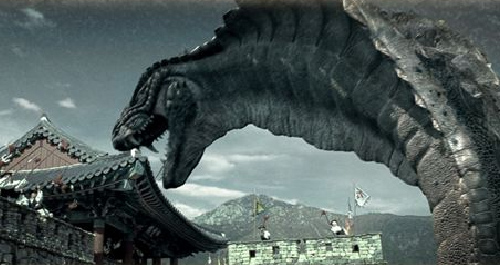 Finally, after a freaky week of fires, evacuations and bright red skies at night, things are settling down in San Diego, and so it is with great joy that my mind has settled and I can fill everybody in on what turned out to be the first film festival that I have ever attended. How appropriate is it for me (an Asian film fan, gladly boasting a video collection of over 3300 Chinese martial arts films – almost half of them on betamax) that my first festival was the 2007 SAN DIEGO ASIAN FILM FESTIVAL. It was also an honor to have the festival ask me to be an official blogger, providing me with a press pass, and of course now that I live in San Diego, I was there 8 days out of the week and took in about 24 films. As they say in mandarin Chinese, “Hao” (good). Continue reading “Out from the Ashes of the San Diego Asian Film Festival”
Finally, after a freaky week of fires, evacuations and bright red skies at night, things are settling down in San Diego, and so it is with great joy that my mind has settled and I can fill everybody in on what turned out to be the first film festival that I have ever attended. How appropriate is it for me (an Asian film fan, gladly boasting a video collection of over 3300 Chinese martial arts films – almost half of them on betamax) that my first festival was the 2007 SAN DIEGO ASIAN FILM FESTIVAL. It was also an honor to have the festival ask me to be an official blogger, providing me with a press pass, and of course now that I live in San Diego, I was there 8 days out of the week and took in about 24 films. As they say in mandarin Chinese, “Hao” (good). Continue reading “Out from the Ashes of the San Diego Asian Film Festival”
Tag: Fant-Asia
San Diego Asian Film Festival
If you are a major fan of Asian films like me, then perhaps that buzz you hear behind you is not a swarm of bees filled with the rage of alarm pheromone fury chasing you, but the electric, eclectic fizzing sibilation of the fast approaching 2007, San Diego Asian Film Festival (SDAFF), which will be held in San Diego, October 11th – 18th.
Although Asia’s most successful genre is martial arts, over the past 10 years, one could argue that macabre Japanese, Korean and even Thai horror movies have now slithered, oozed and floated into the American consciousness. Then of course there is a consistent hypnotized fan base in the U.S. that have been sucked into the freaky world of Japanese anime, something tht (you may not have realized) subliminally began when you were a kid watching KIMBA THE WHITE LION or ASTROBOY. Continue reading “San Diego Asian Film Festival”
Dragon Wars: D-War (2007) – Fantasy Film Review
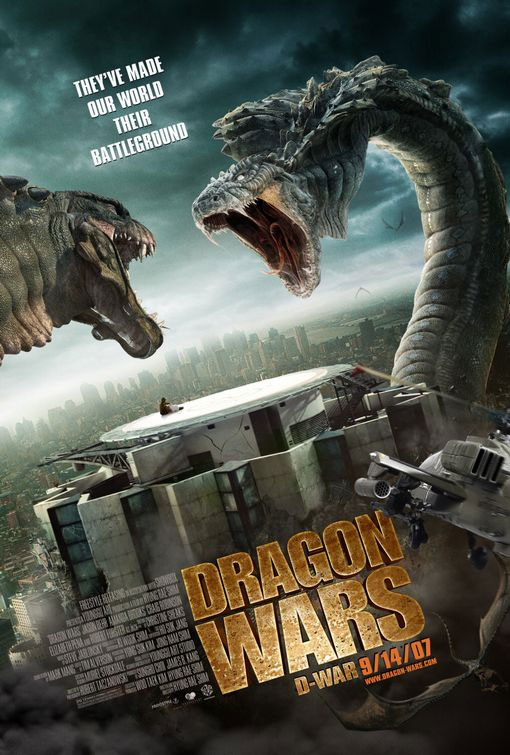 A movie does not have to be good to be entertaining. If there were any doubt about the truth of this axiom, along comes DRAGON WARS (subtitled D-WAR on screen), offering up conclusive proof. By no reasonable reckoning can the film be considered a competent piece of cinematic storytelling, yet somehow the movie transcends its silly screenplay with over-the-top action and visually imaginative battles that are good enough to qualify as mindless fun. The result is not high camp in the so-bad-it’s-funny mold of MIGHTY PEKING MAN; this is really more an example of a low-ambition popcorn movie with enough good sequences to compensate for the unintentional laughter.
A movie does not have to be good to be entertaining. If there were any doubt about the truth of this axiom, along comes DRAGON WARS (subtitled D-WAR on screen), offering up conclusive proof. By no reasonable reckoning can the film be considered a competent piece of cinematic storytelling, yet somehow the movie transcends its silly screenplay with over-the-top action and visually imaginative battles that are good enough to qualify as mindless fun. The result is not high camp in the so-bad-it’s-funny mold of MIGHTY PEKING MAN; this is really more an example of a low-ambition popcorn movie with enough good sequences to compensate for the unintentional laughter.
DRAGON WARS quick-starts with a nice aerial view of a devastated area – the first evidence of dragon activity in a modern day metropolis. The sight of a large reptilian scale leads our hero Ethan (Jason Behr) into an abrupt childhood flashback, when an antique dealer named Jack (Robert Forster) conveniently told him (and by extension the audience) everything necessary to make sense of the plot. This clunky exposition feels like receiving a condensed crash course in Eastern mythology, and you will quickly lose track of the various oddly named entities, whose cosmology seems at least as complex as the choirs of angels in Zoroastrianism (let’s see: cherubim, seraphim, etc.).
Although the young Ethan is clearly perplexed by this deluge of information, Jack never bothers to render it in terms that might be understandable to a boy born in the 20th Century. What it boils down to is this: There is a magical power that will turn a great and worthy serpent into a heavenly dragon, but there is an evil serpent that wants to steal this power. Heaven has hidden this power in a human woman and sent two guardians to protect her (Jack and Ethan), but there is also a marauding army in the service of the evil serpent.
Ethan’s childhood flashback flashes back a further five hundred years to show all of this back story played out in Korea. This sequence captures a beautiful sense of colorful Fant-Asia sword-and-sorcery, a la A CHINESE GHOST STORY, and for awhile it seems as if DRAGON WARS may actually turn out to be good. But then the evil army attacks the peaceful village, and the first major stupid plot points emerges: the two good guys have had twenty years to prepare for this, but when the crisis hits, they seem to be out to lunch, offering little defense until after the village has been thoroughly ravaged. (Why the forces of Good have only two heroes, while the Evil side can muster an entire army, is a question that goes unanswered throughout.)
Five hundred years later, the events play out again, with the three principal characters having been reincarnated in Los Angeles. Strangely, the two guardians have not learned the lesson of the past; even after five centuries, they are still no better prepared for the attack they know is coming. There seems to be no plan, and the action consists mostly of trying to outrun the threat.
Unfortunately, this approach leads DRAGON WARS straight into one of the worst cliches of cinema: we’re supposed to identify with the lead characters and care what happens to them, but everybody else can just fend for themselves. After Ethan tracks down Sarah (Amanda Brooks), the two of them lead the evil serpent on a merry chase through the streets of Los Angeles, stopping at various houses, restaurants, and office buildings, all of which are promptly destroyed. Yet the couple never for a moment shows any sense of guilt or regret about exposing untold innocent by-standers to the danger that is following them.
We in the audience are not supposed to care about this; we are supposed to sit back and simply enjoy the ride. The movie itself feels little concern about barreling ahead at full-speed regardless of logic. This has some benefits. There is an obligatory scene of a zookeeper put in a straitjacket after describing a giant serpent eating the elephants (you would think the zoo could at lest confirm that the elephants were missing), but the authorities quickly – if not very convincingly – realize the truth of the situation, sparing us the usual “there must be some other explanation” dialogue. Unfortunately, the gambit goes too far, with Anglo FBI officers suddenly up to speed on ancient Korean mythology – there must be a folder on it buried in the X-Files somewhere.
Movies can overcome credibility problems if they offer their audience some sort of emotional bond that will convince them to overlook leaps in logic, but even in that regard DRAGON WARS falls short. Actors Behr and Brooks are given absolutely zero to work with in terms of characterization: there is not a single distinguishing trait between the two of them; they play archetypal romantic leads, who fall in love because the script tells them to, not because there is any chemistry between them. On top of this, Behr’s Nathan is exceedingly lacking as a hero. He does little useful, nothing clever; his one achievement (taking a bullet aimed at Sarah) is undermined when – laughably – he simply stands up immediately afterward and says he’s okay, then resumes the action as if nothing had happened.
In the Merlin role, Forster comes across like a more tangible version of the ghostly Ob-Wan Kenobi. After the early flashback, he pops up at convenient moments to lend assistance, but it is never clear why he does not stick around instead of disappearing like the Lone Ranger without waiting for a thank you (a tactic that elicits laughter in at least one case, when he lurches abruptly off-camera after beating up three guys who were harassing Sarah). There is just barely a hint that the leader of the evil army may have killed Jack, which would explain why he appears and disappears like a ghost; perhaps this is one of the seventeen minutes of footage that was deleted since the 107-minute version screened at the American Film Market last November.
With all this against it, what does DRAGON WARS have to offer? It allows Korean writer-director Hyung-rae Shim to take on Los Angeles like a kid trampling a toy train set. The perennial popularity of disaster flicks and giant monster movies suggests there is a vicarious joy in depicting large-scale destruction on screen, and DRAGON WARS delivers the goods. Regardless of the story deficiencies, the film works on a visual level, thanks to the startling sight of ancient, mythical monsters let loose upon a modern metropolis.
All of the genuine imagination went into this aspect of DRAGON WARS, resulting in some memorable set pieces, such as the serpent’s attack on the U.S. Bank Building – the tallest structure in downtown L.A. Not only does the creature pull a civilian helicopter out of the sky (during a lift-off from the landing pad atop the building); the beast also ends up in the target sights of half a dozen military copters – an expertly choreographed sequence that ranks with the best monster movie action ever filmed. Impressively, the scene never degenerates into a circular firing squad; the choppers believably target the moving serpent while avoiding each other, and the computer-effects footage is brilliantly punctuated with live-action shots of Behr and Brooks huddling beneath the rain of spent shells tumbling down from the sky all around them.
This sequence is just a prologue for the epic battle that follows on the streets of the city below, featuring high-tech modern military equipment clashing with an ancient army of armored warriors mounted on reptilian monsters. The special effects may not be totally convincing, but the juxtaposition of anachronistic imagery sells the sequence spectacularly. And in all fairness, the CGI is no more cartoony-looking than that in most American blockbusters, and the action is at least as well staged as anything in this summer’s TRANSFORMERS.
A sequence like this is hard to top, but DRAGON WARS manages the feat. With the connivance of the useless Ethan (who gets knocked unconscious while trying to drive Sarah to safety), the screenplay gets our heroes into the villains’ lair for the climax, a scene that seems equal parts KING KONG and RAIDERS OF THE LOST ARK. Sarah is tied to an altar, to be sacrificed to the serpent god, but a magic amulet finally sparks to life and zaps a bunch of the bad guys. Finally, the Good Serpent (about whom we have heard so much) makes a belated entry to battle his dark counterpart, and the film leaps to a whole new level of outrageous action when the creature absorbs the magic power that transmogrifies it into a Heavenly Dragon. The snake-like, animalistic appearance is replaced by horns and whiskers suggesting ancient Asian dragons, and the body movement takes on an entirely different characteristic: no longer a belly-crawling serpent, this dragon floats majestically on air.
Of course, the outcome of the confrontation is a foregone conclusion, but these clever visual touches make the scene enchanting as well as thrilling, and there is even a touch of pathos at the end. Against all odds, Behr’s final close-up manages to generate a genuine, emotional response; for at least a moment, you will forget the incredible story and buy into the character. This is as close as the human element ever comes to matching the special effects; it is not enough to redeem the shabby dramaturgy of the rest of the film, but it does send the audience away on a good note. In the end, you must be willing to forgive many egregious flaws in order to enjoy DRAGON WARS, but for sci-fi fans who make the sacrifice, the rewards are worth it.
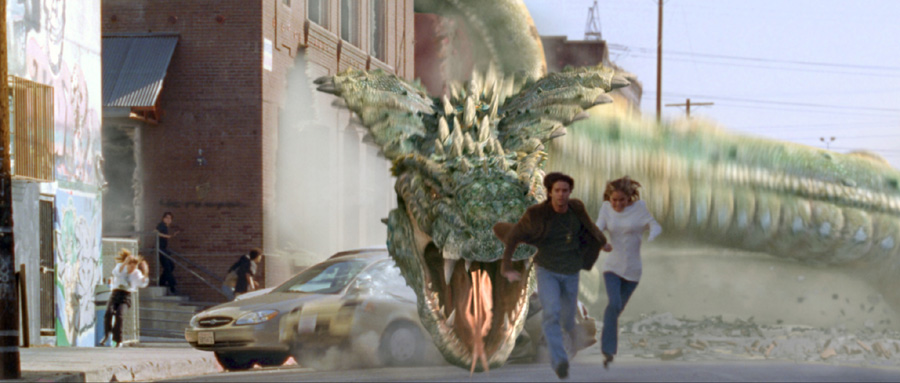
TRIVIA
Although a South Korean production, D-WAR (as it was known in its native land) was shot largely in Los Angeles with an American cast. The budge is rumored to be in excess of $75-million, which includes money spent on developing the facilities necessary to produce the elaborate, computer-generated effects in Korea.
Although many reptilian beasts appear in the film, one could argue that only one qualifies as a true dragon – the one that undergoes the metamorphosis at the end.
DRAGON WARS: D-WAR (a.k.a. “D-War,” 2007). Written and directed by Hung-rae Shim. Cast: Jason Behr, Amanda Brooks, Robert Forster, Aimee Garcia, Craig Robinson, Chris Mulkey, John Ales, Elizabeth Pena, Billy Gardell, Holmes Osborne
Copyright 2007 Steve Biodrowski
[serialposts]
Dragon Wars – Hollywood Premiere
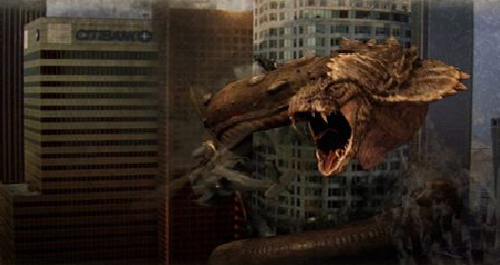
Thanks to the American Cinematheque and Freestyle releasing, Hollywood horror fans got a sneak peak at DRAGON WARS, the Korean produced fantasy film opening Friday. A premiere was held at the venerable Egyptian Theatre, home of the Cinematheque, with many of the cast and crew in attendance: writer-director Hyung-rae Shim and actors Jason Behr, Amanda Brooks, and Robert Forster.
Outside the theatre, the courtyard was filled with paparazzi snapping photos and shooting video of the celebrities, posed in front of a wall of poster art from the Korean-produced film. The usual casual attire seen at Cinematheque screenings was replaced by sleek, black suits and swanky dresses, creating the aura of a genuine event – the people behind this film really seem to think it will do some business.
Inside, Keith Aiken (of scifijapan.com) briefly introduced the film. Two representatives from Freestyle Releasing, the film’s American distributor, made some comments, filling in details about how D-WAR (as it’s known in its native land) managed to earn a wide release stateside. The gist of the tale is that, after the release of THE HOST (which did okay on the art house circuit but did not break out to wide circulation), someone brought a DVD of D-WAR to Freestyle, hoping for a 1,000-theatre opening. Initial skepticism on the part of Freestyle gave way after viewing a sample of the spectacular effects scenes, but what really sold the company was when D-WAR’s debut in Korea earned $20.5-million worth of tickets in its first five days, going on to tally over eight million tickets sold – enough to indicate that the film had the makings of a blockbuster. Consequently, the proposed 1,000 theatre release was expanded to over 2,000.
After the prefatory remarks, DRAGON WARS unspooled for the enthusiastic audience. Without getting into a full-length review here, it became apparent all too soon that the most compelling story about DRAGON WARS is the behind-the-scenes tale of how the Korean film managed to secure a wide release in the U.S. It’s unusual for a foreign production to receive this treatment, but DRAGON WARS is not your typical art house effort. Shot largely in Los Angeles, with English-speaking actors, the film seems deliberately designed to avoid the fate of most foreign hits (e.g., RING, JU-ON): that is, having the remake rights sold while the original is shunted off to video. DRAGON WARS is obviously intended as an American-style blockbuster; unfortunately, the film suffers from the flaws that mar American spectacles: the story is weak when it’s not outright silly; there is little if any attention lavished on the characters and performances; and all the real imagination seems to have been devoted to the special effects.
The good news is that, despite the dramatic weaknesses and gaping plot holes (no doubt due to removing fifteen minutes to speed up the pace of the U.S. cut), DRAGON WARS works because it delivers spectacular monster action. The special effects set pieces are brilliantly conceived and executed; it not utterly convincing, they are less cartoony than similar footage in many American films, and there is an impressive attempt at using light and shadow to make the beast seem truly like a part of the environment.
The audience ate it up, delivering ringing rounds of applause, and actor Robert Forster, who was sitting across the aisle from me, expressed his enthusiastic endorsement. (Despite his short screen-time and a conflict with a current acting gig, he had made a special effort to attend the screening.)
At the reception afterwards, most of the comments were positive, although the flaws did not go unnoticed. The general consensus was that DRAGON WARS is front-loaded with complex exposition that might not be clear to American viewers, and some of the big dramatic moments might have more resonance with Korean viewers (as when a mystical talisman, at a crucial moment, comes to life with a powerful, glowing burst of energy that saves the hero). I eagerly championed this theory, based on the evidence of two Korean gentlemen who had been sitting beside me during the screening: they had gasped in awe-struck simultaneous whispers recognition at each such juncture as we were describing: “OHHHHHHHHHHHHHHHHH!” I remembered feeling vaguely jealous that they were obviously getting more of the film than I was.
Of course, premiere audience reactions, with the filmmakers – and their friends and family – in attendance, can be misleading. It will be interesting to see how DRAGON WARS goes down with a general audience, but it does have the potential to be a sleeper hit with audiences eager for more TRANSFORMERS-type battle action in the streets of a major city. And we all know that the rest of the country – jealous of Los Angeles because we have the film industry, good weather, beaches filled with beautiful women – are probably eager to see the town destroyed by rampaging reptiles.
[serialposts]
Zebraman – Film Review
I keep forgetting that Takashi Miike can do other things besides shoving needles into a whore’s gums (those guys at Showtime are a buncha pussies). ZEBRAMAN is more in the HAPPINESS OF THE KATAKURIS mode, but going even lighter on the black humor. There’s still a bit of splooshiness here and there, but if what you know of the director is AUDITION and IMPRINT, his expansiveness here will surprise you.
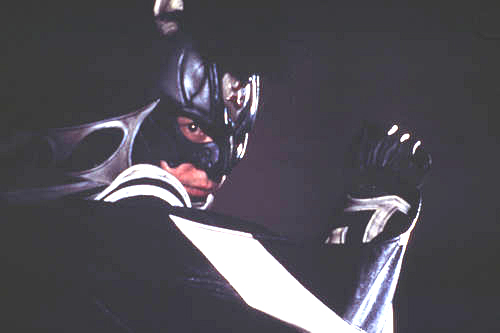
THE HOST: An Interview with Bong Joon-ho
THE HOST, which reached U.S. video store shelves today after an art house release in March, is – first and foremost – a great monster movie. However, it achieves greatness by striving to work as a good movie in all departments. The Korean film introduces its monster early – in broad daylight – yet much of the horror comes from watching the film’s protagonists, a family whose daughter has been snatched by the creature, fight against numerous obstacles, including their own government, to try to effect a rescue. There is a heavy dose of political satire in the film, which plays almost like a 1970s conspiracy movie (e.g., THE PARALLAX VIEW), with military and government forces shown as at best indifferent and at worst corrupt and outright hostile to the concerns of the citizens.
This element of political satire may be confusing to American viewers, who know of the Republic of Korea (popularly called “South Korea”) as a democracy partitioned off from northern half, which has remained under communist control since the end of the Second World War. However, South Korea has its own history of political turmoil and quasi-totalitarianism, hiding behind the façade of democracy – a history that THE HOST obliquely addresses in the character of a former student protestor who laments that he wasted his youth fighting for democracy in his country, only to see the government turn against his family in their time of need.
Earlier this year, I got the chance to talk to Bong Joon-ho, the creator and director of THE HOST (he conceived the story and co-wrote the script with Hah Joon-won and Baek Chul-hun). I took the opportunity to address some of the issues that might not be clear to Western audiences. Hopefully, this little primer will fill viewers in on the context, so that they can sit back and enjoy the thrill ride without scratching their heads.
In the film, Park Gang-du is the eldest of three siblings, working at his father’s food stand near the Han River. When the creature attacks the crowds picnicking on the riverbank one day, the simple-minded man sees his daughter Hyun-seo (Ko A-sung) grabbed and apparently swallowed whole. Later, he receives a brief cell phone call from Hyun-seo, who tells him that the monster deposited her in a sewer, from which she cannot escape. Gang-du tries to enlist the aid of authorities, but they take his unlikely sounding tale as evidence of grief, stupidity, or viral infection; consequently, he and his family break out of quarantine to find Hyun-seo on their own. The film celebrates the resilience of the family unit fighting against great odds while portraying the authority figures alternately as buffoons or unethical psychopaths.
Regarding this negative portrait of the government, Bong Joon-ho explains, “There are lots of elements of satire here. I think it’s because we have a lead protagonist family that are weak and powerless. I sometimes wonder if, for the weak and the powerless, democracy might not be such a huge help. It does take on that perspective. In regards to Korean society or some other countries, I wonder how much the system really protects the weak. That’s definitely reflected in this film. Our family is going on this long journey, but no one helps them at all. That becomes the focal point of the satire. Even though our military dictatorship is over and it’s more democratic than the past, there’s always this sort of thing remaining there, especially for the lower class.”
Park Nam-il (Park Hae-il), Gang-du’s younger brother who is an unemployed college graduate, resorts to tossing Molotov cocktails at the beast during the climax, and we’re clearly supposed to see this as a reversion to his former days as a student protesting against the government – even though he seems too young to have been involved in such activity, which ended at least a decade ago. Bong Joon-ho sees this as a deliberate echo of the past.
“Yes, any protest these days would be done by civil organizations, and they’re quite peaceful,” he admits. “The time of Molotov cocktails and violent demonstrations pretty much ended in the mid-‘90s, so it’s about ten years ago when there was such violent protesting. The second son is sort of like a remnant of that time. In the past he was a protestor; now he is unemployed. When you look in terms of this character, it’s sort of like the feeling of time going backwards. In the beginning, he’s always just complaining. In the middle, after his father dies, he hides in the darkness, then goes and meets up with his old college buddy. By the climax, with Molotov cocktail in hand, it might almost be the image of him in the mid-‘90s. You could say that he is the image of the college protestor back ten years ago; it doesn’t exist in the present day.”
Not only the South Korean government – also the U.S. military presence in the country comes under satirical scrutiny in the film. In the prologue, an American military doctor (Scott Wilson) orders his Korean subordinate to dump toxic chemicals into a drain that leads to the Han River, and the film leaves us in no doubt that this toxic waste is responsible for the mutated creature that emerges six years later. Much of the film deals with government attempts to quarantine people who have come in contact with the creature, because the United States insists that it is the “host” of a contagious virus. Toward the climax, the U.S. intervenes, dosing the city with an anti-bacteriological substance called “Agent Yellow” (obviously named after “Agent Orange”) with little concern for possible side effects on the human population.
Bong Joon-ho sees this plot thread as a standard part of the science-fiction genre (which often relies on nefarious conspiracies to explain the existence of a monsters) as opposed to an overtly anti-American agenda.
“It is true that there is lots of political satire in this film, and that was quite intentional,” he explains. “In regards to the opening scene, there was a famous case seven years ago, where toxins were poured into the Han River. I felt that story also goes in tune with the conventions of the monster genre. For someone who’s preparing a film of a creature coming out of the Han River, to have a case like this in front of me became a very good starting point, and I was very inspired by that event. That was the inspiration for the opening scene and the starting point for the whole story. Of course there would be a line of satire of America; it just became very natural to have it, and it follows in the conventions of the monster genre. But in the broad sense, to compress it or simply it as an anti-American film, I think that’s not correct because there’s always a history of political satire in the sci-fi genre. If you look in the broad sense, the American satire is just one part of it. There is also the satire against the Korean society and, even further, the whole system that doesn’t protect the weak people. That’s the greater flow of satire in this film, not that one part of anti-Americanism.”
Perhaps the first sign that THE HOST is not just another monster movie occurs during the prologue when American actor, Scott Wilson (who played opposite Robert Blake as one of the two stone cold killers in the film version of IN COLD BLOOD) shows up, as an American army doctor. Later, Paul Lazar makes an equally disturbing appearance as another American scientist, who insists that a brain sample needs to be taken from Park Gang-du, the distraught father of the missing girl, in order to “prove” the existence of the virus, which has yet to be isolated. The combined screen time for both actors is only a few minutes, but their presence distinguishes THE HOST from Japanese monster films (like GODZILLA VS. KING GHIDORAH), which typically cast non-professionals when they need to portray American characters.
“It’s also in Korean films where if you had American characters or English-speaking characters, they were cast among American’s living in Korea,” says Bong Joon-ho. “I didn’t like that because it does lower the professionalism of the whole thing. Even though it’s only one scene here and one or two scenes there, I wanted to get professionals to do it right. Paul Lazar was in Jonathan Demme’s SILENCE OF THE LAMBS and also PHILEDELPHIA. In SILENCE OF THE LAMBS he played an insect specialist who made a pass at Jodie Foster; that left a deep impression with me. In terms of Scott Wilson, he’s a famous actor I respect greatly; I have the DVD of IN COLD BLOOD. Knowing his history, I was quite respectful, and that’s way I tried to go for casting him. The whole casting process was actually very by-the-book: I sent them the script along with the DVD of my previous film, MEMORIES OF MURDER; they said yes quite easily. We matched their schedules; they came to Korea, and we shot the whole thing. I was a little concerned about the communication aspect myself, but working with an interpreter it didn’t become a huge problem at all.”
In the great tradition of monster movies, the forces responsible for the beast’s existence remain at the conclusion of the film. When the “Host” itself comes under fire at the climax, you realize that the real villains (the government and military forces) are getting off the hook for their involvement, which leaves the door open for a sequel. Bong Joon-ho expresses no particular interest in doing a follow-up, but the rights for an American remake have already been snagged by Universal Pictures at last year’s American Film Market.
Says Bong Joon-ho, “Whether it be a sci-fi film or a monster film, I would like to do a different type of story [next]. Whatever story I take on next, whatever genre I choose, I’d like to recreate the genre, breathe new life, or find a new form of storytelling with the genre. Except for the musical genre!”

